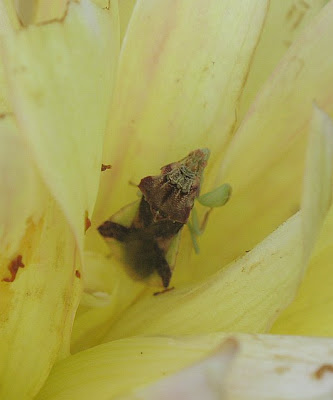

When I was photographing some Dahlias I came across this tiny bug, about 1/4" long with green paddle front legs. I haven't a clue as to what it is. It didn't seem too perturbed by the closeness of the camera lens and moved only slightly when I got too close or moved some petals to expose it more fully.
It has an almost Egytian looking headdress and delta wings which are kinda neat but I wonder what those front legs were meant for? I don't think it is used for locomotion in water.
Update: Thanks to
Annie in Austin the bug has a name -
Ambush Bug, Family Phymatidae from the "What's That Bug" website. The Ambush bug is halfway down the web page.
Here's a quote from the website " The lethargic behavior you describe is the key to the hunting strategy of the Ambush Bug, Family Phymatidae. These bugs usually wait on flowers for much larger insects to arrive and then pounce with those raptorial front legs. A tiny Ambush Bug is capable of subdueing a much larger bee. Their protective coloration will camoflauge them very well on such plants as goldenrod."
Futher, " You have an Ambush Bug, Family Phymatidae. These are True Bugs and closely related to Assasin Bugs, hence the similarity in appearance. According to Borror and Delong: "The Phymatids are small stout-bodied bugs with raptorial front legs. ... Most of the Ambush Bugs are about 1/2 inch in length or less, yet they are able to capture insects as large as fair-sized bumble bees. they lie in wait for their prey on flowers, particularly goldenrod, where they are excellently concealed by their greenish yellow color. They feed principally on relatively large bees, wasps, and flies." They do have venom, hence the pain in your bite. As you know, their bite is painful, but not dangerous. I believe your species is Phymata erosa."
And
here's a site that shows an amazing photo of the Ambush bug capturing a much, much larger wasp.
And
another site showing it capturing and devouring a butterfly, again many times its size.
The bug seemed to be so slow moving, small and innocuous, I'm surprised at how ferocious it is! I'll have to be more careful having been stung by the yellow jacket already this summer. I don't want to experience the venomous bite of the Ambush bug too.

Here's a closer look.

























































